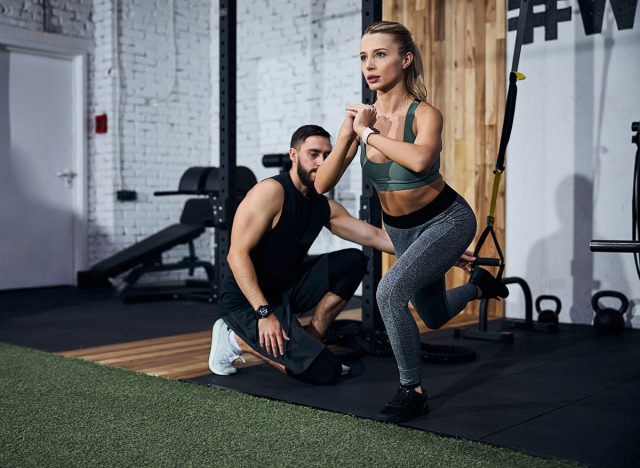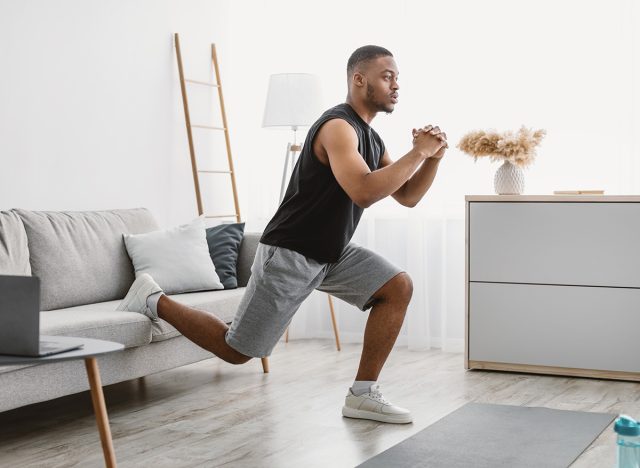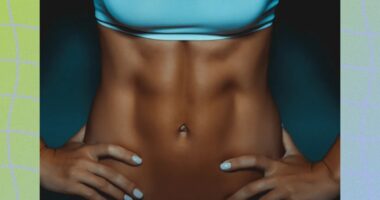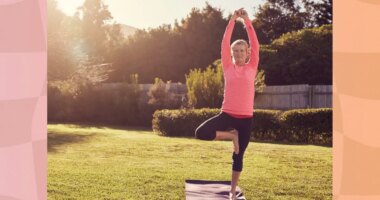Jessica Biel is many things: an actress, producer, wife (married to superstar Justin Timberlake), mom of two, and our summer fitness inspiration. The 41-year-old, who rose to fame on 7th Heaven, is known for her undeniable talent and her ability to do everything from comedy to horror and drama, but also for her sculpted physique. While her chiseled arms, leg, and abs are envy-worthy, Biel has always been active and works hard at staying in shape. She recently gave fans a glimpse of one fierce workout she does to keep her legs toned–single-leg squat with a weight, followed by a side lunge. Here’s everything to know about the intense move and why it works according to ACE-certified trainer and nutritionist Mary Sabat, MS, RDN, LD.


In the video posted to Instagram, Biel is seen wearing turquoise leggings and a black hoodie doing the epic workout with a cameo at the end from her husband. This type of workout is effective for a few reasons, according to Sabat:
- “Lower body strength: This exercise targets the muscles in the lower body, particularly the quadriceps, hamstrings, glutes, and adductors. It helps to build strength, stability, and balance in these muscles.
- Core activation: Maintaining balance during the single-leg squat engages the core muscles, including the abs and lower back.
- Functional movement: The exercise mimics real-life movements, such as getting up from a chair or climbing stairs, making it a functional exercise that translates into improved daily activities.”


To ensure you’re getting the most out of the workout, form, and technique are key. Sabat explains the proper way to perform the exercise correctly. Here are some key points to focus on, Sabat says.
- “Start by standing tall with the weight held next to the chest, ensuring a firm grip.
- Lift one leg off the ground, keeping it slightly extended in front.
- Slowly lower your body down into a squat position on the standing leg, while maintaining a straight back and keeping the knee in line with the toes.
- Go as low as you can comfortably control, aiming for a 90-degree angle at the knee.
- Push through the heel of the standing leg to return to the starting position.
- Immediately move into a side lunge by stepping the same leg out to the side, bending the knee, and pushing the hips back.
- Maintain an upright posture, keeping the chest lifted and the knee aligned with the toes.
- Push back to the starting position and repeat the sequence on the other leg.”


Single-leg squat with a weight, followed by a side lunge is not easy, so don’t get discouraged if it’s something you can master the first time. There are ways to modify the move. Sabat explains, “If the exercise feels too challenging or you need to make modifications, here are some options:
- Bodyweight-only version: Start by performing the single-leg squats and side lunges without using any weights. Focus on maintaining proper form and control before adding external resistance.
- Reduce the range of motion: If you have difficulty going into a full squat or side lunge, you can decrease the depth and range of motion until you build enough strength and flexibility.
- Use lighter weights: If the weight being held next to the chest feels too heavy, you can start with lighter dumbbells or kettlebells until you become more comfortable and stronger.”
READ RELATED: 3 Natural Ayurvedic Remedies For Oily Skin


Learning a new workout can be challenging, and there are a few wrong ways to do this move. Here’s what to avoid; Sabat warns not to do the following:
- “Rounded back: Avoid rounding your back during the movement. Maintain a neutral spine and keep your chest lifted throughout.
- Knees collapsing inward: Be mindful of your knee alignment. Avoid allowing the knee to cave inwards during the squat and lunge. Instead, keep your knees in line with your toes.
- Lack of control: Ensure that you have control over the movement and don’t rush through it. Focus on engaging the muscles and maintaining stability throughout each repetition.”


Like with any workout, injury is always a possibility, so to ensure you’re doing the move correctly, Sabat gives the following safety tips.
- “Warm up properly: Prioritize a dynamic warm-up to prepare your muscles and joints for the exercise. This can include activities such as jogging, leg swings, or bodyweight squats.
- Start with proper form: Begin with bodyweight squats and lunges to master the movement pattern before adding weights. This helps develop strength and stability in the correct form.
- Progress gradually: Gradually increase the weight and intensity of the exercise over time as your strength and technique improve.
- Listen to your body: If you experience pain or discomfort, especially in your knees or lower back, stop the exercise and consult with a qualified fitness professional.
- Use appropriate weights: Choose weights that challenge you but still allow you to maintain proper form and control. Using excessively heavy weights can compromise your technique and increase the risk of injury.”
Performing a single-leg squat with a weight followed by a side lunge offers a multitude of benefits for overall fitness and strength. Firstly, these exercises enhance balance and stability as they require engaging multiple muscle groups to stabilize the body during dynamic movements. Secondly, they target the glutes, quads, hamstrings, and core, fostering leg and core strength. Moreover, the unilateral nature of the exercises helps identify and rectify muscle imbalances, reducing the risk of injury in daily activities and sports. Additionally, they promote functional strength, improving performance in various sports and activities that involve lateral movements. Lastly, these compound exercises efficiently burn calories, aiding in weight management and sculpting lean muscle.
Heather Newgen










